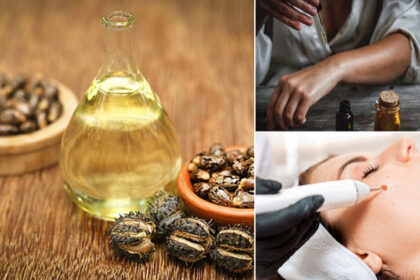Detoxifying the Body: Best Nutrients and Superfoods to Remove Plastics
Plastics have become an ubiquitous part of modern life, infiltrating everything from our household items to our food chain. Microplastics, tiny plastic particles less than five millimeters in size, are now found in the air we breathe, the water we drink, and the food we eat. These microplastics can accumulate in the body and potentially cause various health issues. Detoxifying the body from these harmful substances is crucial for maintaining overall health. Fortunately, certain nutrients and superfoods have shown promise in aiding the removal of plastics and other toxins from the body. This article explores some of the best options available.
Before we get into solutions however I think it’s important to explore how plastic harms our health, particularly our hormonal health as it confuses the body in multiple ways.
Worldwide, humans potentially ingest between 11,845 to 193,200 microplastics per person per year ranging between 7.7g and 287g per person per year with the largest source by far being drinking water. Both tap water and bottled water play a large role here. That’s why one of the best investments that you can make for your health is to get a high quality water filter. I use Omica Organics water filters, which you can learn more about by visiting their website OmicaOrganics.com. Omica Organics has filters for both drinking and shower water to remove micro-plastics, chlorine, heavy metals, traces of pharmaceutical drugs and more. You can also get 10% off your water filter with the discount code: healthywildfree.
Plastics disrupt hormones through their content of endocrine-disrupting chemicals (EDCs), which can interfere with the body’s hormonal balance. These chemicals include bisphenol A (BPA), phthalates, and various other compounds that mimic, block, or otherwise interfere with the natural hormones in the body. Here’s a detailed explanation of how these chemicals work and their effects:
1. Mimicking Natural Hormones
Some EDCs in plastics, like BPA, can mimic natural hormones. BPA structurally resembles estrogen, the primary female sex hormone, allowing it to bind to estrogen receptors on cells. This binding can activate or block the receptors, leading to various health issues.
- Effects: Mimicking estrogen can disrupt normal reproductive development, potentially leading to fertility issues, developmental problems, and increased risk of hormone-related cancers like breast and prostate cancer.
2. Blocking Hormone Receptors
Certain plastic chemicals can block hormone receptors, preventing natural hormones from binding to their respective receptors. For example, some phthalates can block androgen receptors, affecting male hormone function.
- Effects: Blocking androgen receptors can interfere with male reproductive development, reduce sperm quality, and lead to other reproductive issues. It can also affect muscle mass, energy levels, and overall male health.
3. Altering Hormone Synthesis and Metabolism
EDCs can alter the synthesis, release, and metabolism of natural hormones, disrupting their normal levels and functions in the body. For instance, exposure to certain phthalates can alter thyroid hormone levels, affecting metabolism and energy regulation.
- Effects: Disruption in thyroid hormones can lead to metabolic disorders, weight gain or loss, fatigue, and other issues related to energy regulation. Altered hormone synthesis can also impact growth, development, and other critical bodily functions.
4. Interfering with Hormone Transport
Plastics can contain chemicals that affect the proteins responsible for transporting hormones through the bloodstream. This interference can alter hormone levels in target tissues and disrupt normal hormonal signaling.
- Effects: Changes in hormone transport can lead to imbalances that affect various bodily systems, including the reproductive, metabolic, and nervous systems.
5. Epigenetic Changes
EDCs in plastics can cause epigenetic changes, which are modifications in gene expression without altering the DNA sequence. These changes can affect how cells respond to hormones, leading to long-term health effects.
- Effects: Epigenetic changes can be passed down to future generations, potentially leading to multigenerational health impacts. These changes can affect everything from reproductive health to the risk of developing chronic diseases like diabetes and cancer.
Health Implications of Hormonal Disruption
The disruption of hormones by plastics can lead to a range of health problems, including:
- Reproductive Issues: Infertility, developmental abnormalities, and hormonal imbalances in both males and females.
- Metabolic Disorders: Obesity, diabetes, and other metabolic conditions due to disrupted thyroid and other hormone functions.
- Neurological Effects: Impacts on brain development and function, potentially leading to cognitive and behavioral issues.
- Increased Cancer Risk: Hormone-related cancers, such as breast, prostate, and ovarian cancer, due to the estrogen-mimicking effects of certain EDCs.
- Immune System Disruption: Altered immune responses, potentially leading to autoimmune diseases and reduced ability to fight infections.
Reducing Exposure to Plastic EDCs
To minimize the hormonal disruption caused by plastics, consider these steps:
- Avoid Plastic Containers: Use glass, stainless steel, or ceramic containers for food and beverages.
- Check Labels: Look for BPA-free and phthalate-free products.
- Limit Processed Foods: Processed foods can contain higher levels of EDCs from packaging materials.
- Use Natural Products: Choose personal care products and household cleaners made with natural ingredients.
- Filter Water: Use a water filter to reduce contaminants, including EDCs, from tap water.
By understanding how plastics disrupt hormones and taking steps to reduce exposure, individuals can help protect their health and mitigate the risks associated with these pervasive chemicals.
11 Solutions To Pull Plastic Out Of Your Body
1. Chlorella
Chlorella is a type of freshwater algae that has gained popularity as a detoxifying superfood. It is rich in chlorophyll, which helps cleanse the bloodstream and liver. Chlorella has a unique ability to bind to heavy metals, chemicals, and other toxins, including microplastics, and facilitate their removal from the body.
Nutritional Benefits:
- High in protein, vitamins, and minerals
- Contains chlorophyll, which aids in detoxification
- Rich in antioxidants that combat oxidative stress
You can get chlorella tablets or powder from Starwest Botanicals by clicking here.
2. Spirulina
Spirulina is another type of algae known for its detoxifying properties. It contains phycocyanin, a pigment with potent antioxidant and anti-inflammatory effects. Spirulina can bind to toxins, including microplastics, and help eliminate them through the digestive system.
Nutritional Benefits:
- Packed with protein, vitamins, and essential fatty acids
- Contains powerful antioxidants like phycocyanin
- Supports liver and kidney function, aiding in detoxification
You can get spirulina powder or tablets from Starwest botanicals by clicking here.
3. Cilantro (Coriander)
Cilantro, commonly used as a culinary herb, is an effective natural chelator. It binds to heavy metals and other toxins, facilitating their removal from the body. Cilantro is particularly effective when used in combination with other detoxifying agents like chlorella.
Nutritional Benefits:
- Rich in vitamins A, K, and C
- Contains antioxidants that protect against free radicals
- Supports detoxification pathways in the liver
4. Garlic
Garlic has been used for centuries for its medicinal properties. It contains sulfur compounds that enhance the body’s detoxification processes. Garlic can help remove heavy metals and other toxins, including microplastics, by boosting the production of detoxifying enzymes in the liver.
Nutritional Benefits:
- Contains allicin, a compound with antibacterial and detoxifying properties
- Rich in vitamins and minerals, including vitamin C and selenium
- Supports immune function and overall health
5. Turmeric
Turmeric, a spice commonly used in Indian cuisine, contains curcumin, a powerful antioxidant and anti-inflammatory compound. Curcumin enhances the liver’s ability to detoxify harmful substances and may help reduce the impact of microplastics on the body.
Nutritional Benefits:
- Contains curcumin, a potent anti-inflammatory and antioxidant
- Supports liver health and detoxification processes
- May help protect against chronic diseases
I get my turmeric from Omica Organics as they use biodynamic growing practices which use absolutely ZERO pesticides. This turmeric is higher quality than the organic turmeric you can get at your local health food store. How do I know? I’ve tested it! It’s a brighter color, stronger smell and taste. It’s much more medicinal.
Click here to visit OmicaOrganics.com and use the discount code: HealthyWildFree to get 10% off your order.
6. Ginger
Ginger is well-known for its digestive benefits, but it also has detoxifying properties. It enhances circulation and helps the body eliminate toxins through sweat and urine. Ginger’s anti-inflammatory properties can also help mitigate the effects of toxins, including microplastics.
Nutritional Benefits:
- Contains gingerol, an anti-inflammatory and antioxidant compound
- Supports digestion and enhances nutrient absorption
- Promotes detoxification through improved circulation
I get my ginger from Omica Organics as they use biodynamic growing practices which use absolutely ZERO pesticides. This ginger is higher quality than the organic turmeric you can get at your local health food store. How do I know? I’ve tested it! It’s a brighter color, stronger smell and taste. It’s much more medicinal.
Click here to visit OmicaOrganics.com and use the discount code: HealthyWildFree to get 10% off your order.
7. Lemon
Lemons are rich in vitamin C and antioxidants, which support the body’s detoxification processes. The citric acid in lemons helps stimulate the liver and promote the production of bile, aiding in the elimination of toxins.
Nutritional Benefits:
- High in vitamin C, which supports immune function
- Contains antioxidants that protect against oxidative stress
- Aids in digestion and detoxification
8. Green Tea
Green tea is packed with antioxidants, particularly catechins, which support detoxification. These compounds help the liver function more efficiently and can bind to toxins, including microplastics, facilitating their removal from the body.
Nutritional Benefits:
- Rich in catechins, powerful antioxidants
- Supports liver health and detoxification
- May help protect against various chronic diseases
9. Apple Cider Vinegar
Apple cider vinegar has detoxifying properties due to its acetic acid content. It helps balance the body’s pH levels and supports the detoxification pathways in the liver. Apple cider vinegar can also aid in digestion and the elimination of toxins through the digestive system.
Nutritional Benefits:
- Contains acetic acid, which supports detoxification
- Helps balance pH levels in the body
- Aids in digestion and nutrient absorption
I get organic apple cider vinegar capsules from Paleovalley. This formula has turmeric, ginger and apple cider vinegar all in one formula which all help to remove plastic from the body. Click here to learn more about this formula and get 15% off!
10. Broccoli Sprouts
Broccoli sprouts are a potent source of sulforaphane, a compound that enhances the body’s detoxification processes. Sulforaphane activates enzymes that help eliminate toxins, including microplastics, and protect cells from damage.
Nutritional Benefits:
- High in sulforaphane, a powerful detoxifying compound
- Supports liver health and detoxification
- Rich in vitamins and minerals
11. Activated Charcoal
While not a nutrient or food, activated charcoal is a powerful detoxifying agent. It works by binding to toxins, including microplastics, in the digestive system and preventing their absorption. Activated charcoal is often used in emergency settings to treat poisoning but can also be used for general detoxification.
Benefits:
- Binds to toxins and prevents their absorption
- Can be used to treat poisoning and overdoses
- Supports digestive health
I get my activated charcoal from Schizandu naturals, you can get powder or capsules. Click here to get 10% off your activated charcoal order.
Conclusion
Detoxifying the body from plastics and other toxins is essential for maintaining optimal health. Incorporating nutrient-rich superfoods like chlorella, spirulina, cilantro, garlic, turmeric, ginger, lemon, green tea, apple cider vinegar, broccoli sprouts, and activated charcoal into your diet can help support the body’s natural detoxification processes. These foods not only aid in the removal of toxins but also provide a wealth of other health benefits, making them valuable additions to a healthy lifestyle. While these superfoods can aid in detoxification, it is also important to reduce exposure to plastics by opting for natural and eco-friendly alternatives in everyday life.





